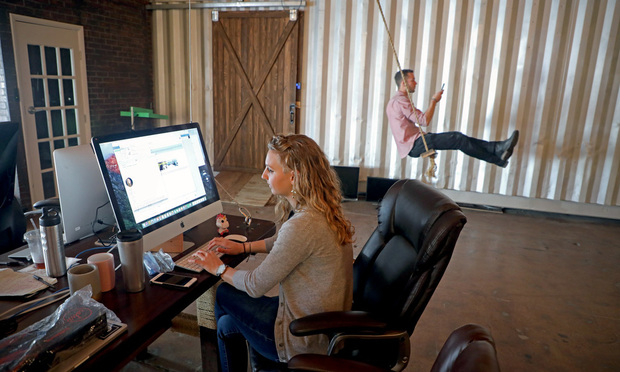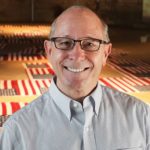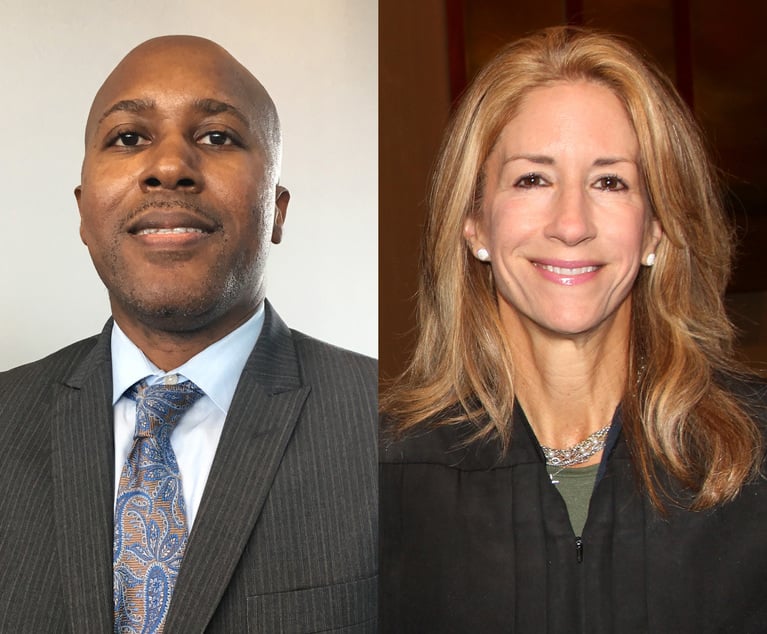Old Warehouses Get New Life as Offices Across South Florida
Companies are shunning office high rises in favor of old warehouses where space can be repurposed on a moment's notice.
February 26, 2018 at 08:00 AM
8 minute read

Stand in front of marketing and production company C&I Studios Inc.'s office in Fort Lauderdale and, if you think it looks like a warehouse, that's because it is.
But walk inside and see the full-blown workspace, including a 2,500-square-foot production studio, another 780-square-foot studio and a community space with bar and lounge.
C&I Studios is among the companies in South Florida, particularly those in the creative fields, opting for retrofitted warehouses as offices instead of glistening downtown high-rises or suburban offices where employees work in cubicles.
“We don't have traditional office space. We work in the arts, so a traditional office space wasn't even an option for us,” said Joshua Miller, CEO of C&I, which brands itself as an idea agency. “We film commercials, we do photo shoots, we create art, so obviously we needed a bigger space to do what we do. Obviously, a warehouse was kind of like the first in mind. We've never even thought about getting something on the 17th floor.”

It's difficult to pinpoint when this trend caught on in the region. Doug McCraw and Lutz Hofbauer started FATVillage, the retrofitted warehouse district where C&I is based, about 20 years ago, McCraw said. But the warehouse district in West Palm Beach, another area where space has been converted to offices, was started about two years ago, said William Earl, who represents owner Johnstone Capital Partners.
FATVillage, starting with an acronym for Flagler Arts Technology, is between Northwest Fourth and Sixth streets and between Andrews Avenue and the Florida East Coast Railway tracks.
In West Palm Beach, the district is a curved block between Elizabeth and Clare avenues and Caroline and Blanche streets with about 85,000 square feet of warehouses for offices as well as businesses. Tenants in the area southeast of Interstate 95 and Okeechobee Boulevard include a 14-vendor food market, antique shop, wooden plank maker and craft brewery, according to the district's website.
Some of the converted warehouses in Fort Lauderdale and West Palm Beach were built as far back as the 1950s, according to the county property records.
“The traditional office-park model, there's still a place for it, but I think there's a large segment of office users who don't desire that kind of traditional setting,” Earl said. “They want to be in a more unique, creative environment with interesting amenities around it, and that's something we are seeing pretty regularly here in our project.”
In Miami, while the trend is most notable and expansive in Wynwood, the global popularity of the neighborhood has made it cost prohibitive to open an office, and some tenants are migrating north to Little Haiti, said Mauricio Zapata, who is a principal and broker for Chariff Realty Group and helped close several warehouse office deals.
Zapata and firm president and broker Lyle Chariff in December represented Jose Sbarra in selling three recently built warehouses.
Sbarra has been developing warehouses in the neighborhood since about 2007, building them to a higher standard than the typical industrial structure and catering to businesses that want to use the space as an office, Zapata said.
“It's a need of sophisticated businesses that want to be close to the action,” Zapata told the Daily Business Review in December. “It's more for like businesses that need space for their own trade. He (a buyer) can go maybe to Doral if he wanted a distribution center. (But) he needs to be close to where he is going to play. He needs something central.”
In some cases, buyers and renters want a warehouse where they can have an office but also need space for materials if they are working on a project nearby.
That seems to be the case with the buyer of Sbarra's three warehouses. Guy Laliberte, the founder and creative guide of Cirque du Soleil, is using the space as an office and for storage while working on Little Haiti's Magic City Innovation District, according to Zapata. Laliberte has partnered with the developers on the proposed mixed-use art, entertainment and technology project.
“They feel better in a place that has high ceilings and is very dynamic,” Zapata said. “They are not accustomed to a typical office environment, and it helps their creativity to be in something different.”
FLEX SPACE
For McCraw, the co-founder of FATVillage, warehouse offices are for those in creative fields as well as those who need to repurpose their space quickly, using it as an office or staging area by day and as an event space by night, he said.
“You have to reconfigure the space based on those projects they are working on,” McCraw said.
His FATVillage office has about 25 employees, some working on the real estate aspect of the district and the rest for FAR Gallery, which shares the same space, he said.
The space can be repurposed as often as twice a day, McCraw added.
“In our office … all the desks are on wheels, all the chairs are on wheels, the conference table is on wheels,” he said. “I've had it happen more than twice in a day where we have a conference table for a conference, and we will have meeting space that needs to be set up differently, and then we'll have it go back to a conference area later.”
That's the case with the other tenants, he added.
“If you come and see these spaces, it may be different next week in the reconfiguration than you see this week. It's almost like an organic process where it's continually changing and morphing, if you will, related to the business space requirements of different projects that are happening,” McCraw said.
C&I can alter its studios; Next Door, the community space with bar and lounge; and The Garden, a 13,000-square-foot outdoor space used for photo shoots, video footage and small concerts.
“It's untraditional. I am not saying that because it's cool and we made it, but you've actually never seen anything like it. There's no cubicles. There's an open-style work environment. It's not like there's cameras and just random warehouse space. People have full-time jobs here,” Miller said.
NOTHING IS BORING
Asked whether C&I has any workspace with desks and cubicles and desks, he said, “We don't really have any boring locations.”
A table can be pulled up to the ceiling to open floor space or pulled down to be used in meeting areas with couches, Miller said.
The open-space office trend is about being in a warehouse that can be repurposed as much as it is about being in a workplace that's designed creatively.
Walk into information technology consulting and services company VXIT in West Palm Beach, and at first it might look like a bar, said managing director Paul Vedder.
“It's all open work space, and all the desks are out in the open. The front desk has seating for 12 people very comfortably at a table and bar area,” he said.
Aside from the bar and kitchen area equipped with a glass-front refrigerator, there are couches, a TV with an Xbox and classic Nintendo games, white boards for brainstorming, a pingpong table and a punching bag used by employees to destress, Vedder said.
Instead of interior walls separating offices, there are slats for dividers, Vedder added.
“It makes for a close-knit team where we are collaborating constantly, where we can hear what's going on. It can get a little noisy from time to time. It definitely works out to where it's a very collaborative environment,” he said.
Digital media company Motorsport Network — which provides global motor sports news on TV, websites and publications and has an e-commerce website — moved its headquarters to a Little Haiti warehouse in early 2017, said Jan Reese, chief financial officer.
The open floor plan makes for much better collaboration and communication among employees, he said. But a warehouse environment isn't really a choice — it's a necessity for the company to thrive.
“If you want to attract talent in Miami, you don't want to be boring, and our office space just reflects this young, hip atmosphere which you would expect when you are in a Miami office,” Reese said.
Zapata, the Miami broker, echoed that.
“These businesses need to make a statement,” he said, “and they don't make a statement by just going to an office tower in downtown.”
This content has been archived. It is available through our partners, LexisNexis® and Bloomberg Law.
To view this content, please continue to their sites.
Not a Lexis Subscriber?
Subscribe Now
Not a Bloomberg Law Subscriber?
Subscribe Now
NOT FOR REPRINT
© 2025 ALM Global, LLC, All Rights Reserved. Request academic re-use from www.copyright.com. All other uses, submit a request to [email protected]. For more information visit Asset & Logo Licensing.
You Might Like
View All
Yacht Broker Says It 'Has Done Nothing Wrong.' Asks Miami Court to Dismiss the Case

Hyper-Reality Revisited: A Tour of Waldorf Astoria Hotel & Residences Miami
5 minute read
10 Years Later, This High Court Fight Over Real Estate Commissions Is Far From Over
4 minute read
Broward Judge Awards $9.9M in Attorney Fees and Costs After $33M Salmon Settlement
4 minute readTrending Stories
- 1Court Rejects San Francisco's Challenge to Robotaxi Licenses
- 2'Be Prepared and Practice': Paul Hastings' Michelle Reed Breaks Down Firm's First SEC Cybersecurity Incident Disclosure Report
- 3Lina Khan Gives Up the Gavel After Contentious 4 Years as FTC Chair
- 4Allstate Is Using Cell Phone Data to Raise Prices, Attorney General Claims
- 5Epiq Announces AI Discovery Assistant, Initially Developed by Laer AI, With Help From Sullivan & Cromwell
Who Got The Work
J. Brugh Lower of Gibbons has entered an appearance for industrial equipment supplier Devco Corporation in a pending trademark infringement lawsuit. The suit, accusing the defendant of selling knock-off Graco products, was filed Dec. 18 in New Jersey District Court by Rivkin Radler on behalf of Graco Inc. and Graco Minnesota. The case, assigned to U.S. District Judge Zahid N. Quraishi, is 3:24-cv-11294, Graco Inc. et al v. Devco Corporation.
Who Got The Work
Rebecca Maller-Stein and Kent A. Yalowitz of Arnold & Porter Kaye Scholer have entered their appearances for Hanaco Venture Capital and its executives, Lior Prosor and David Frankel, in a pending securities lawsuit. The action, filed on Dec. 24 in New York Southern District Court by Zell, Aron & Co. on behalf of Goldeneye Advisors, accuses the defendants of negligently and fraudulently managing the plaintiff's $1 million investment. The case, assigned to U.S. District Judge Vernon S. Broderick, is 1:24-cv-09918, Goldeneye Advisors, LLC v. Hanaco Venture Capital, Ltd. et al.
Who Got The Work
Attorneys from A&O Shearman has stepped in as defense counsel for Toronto-Dominion Bank and other defendants in a pending securities class action. The suit, filed Dec. 11 in New York Southern District Court by Bleichmar Fonti & Auld, accuses the defendants of concealing the bank's 'pervasive' deficiencies in regards to its compliance with the Bank Secrecy Act and the quality of its anti-money laundering controls. The case, assigned to U.S. District Judge Arun Subramanian, is 1:24-cv-09445, Gonzalez v. The Toronto-Dominion Bank et al.
Who Got The Work
Crown Castle International, a Pennsylvania company providing shared communications infrastructure, has turned to Luke D. Wolf of Gordon Rees Scully Mansukhani to fend off a pending breach-of-contract lawsuit. The court action, filed Nov. 25 in Michigan Eastern District Court by Hooper Hathaway PC on behalf of The Town Residences LLC, accuses Crown Castle of failing to transfer approximately $30,000 in utility payments from T-Mobile in breach of a roof-top lease and assignment agreement. The case, assigned to U.S. District Judge Susan K. Declercq, is 2:24-cv-13131, The Town Residences LLC v. T-Mobile US, Inc. et al.
Who Got The Work
Wilfred P. Coronato and Daniel M. Schwartz of McCarter & English have stepped in as defense counsel to Electrolux Home Products Inc. in a pending product liability lawsuit. The court action, filed Nov. 26 in New York Eastern District Court by Poulos Lopiccolo PC and Nagel Rice LLP on behalf of David Stern, alleges that the defendant's refrigerators’ drawers and shelving repeatedly break and fall apart within months after purchase. The case, assigned to U.S. District Judge Joan M. Azrack, is 2:24-cv-08204, Stern v. Electrolux Home Products, Inc.
Featured Firms
Law Offices of Gary Martin Hays & Associates, P.C.
(470) 294-1674
Law Offices of Mark E. Salomone
(857) 444-6468
Smith & Hassler
(713) 739-1250






